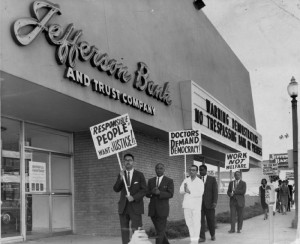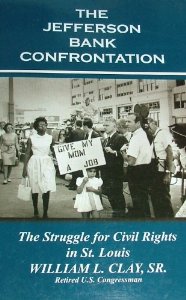
By ROY MALONE
A protest 50 years ago this summer – beginning on Aug. 30, 1963 – pitted angry St. Louis business and civic leaders against young organizers of the Committee of Racial Equality who demanded more hiring of blacks by employers, especially the Jefferson Bank.
By the time the demonstrations stopped, and legal actions ended almost four years later, about 500 persons had been arrested in civil disobedience actions at the bank and other businesses.
There was no violence but there was a sea change in hiring of blacks. CORE leaders called it the most effective struggle for equal rights in the city’s history.
Jefferson Bank had two blacks among its 80 employees; one was a custodian and the other a messenger. It stubbornly refused to negotiate and got a restraining order against interference by picketers and sit-ins. Over the next few weeks the bank hired five more employees, all whites.
Violation of the court order led to 19 CORE members being jailed, convicted, and sentenced to long terms and heavy fines.
One of those arrested was Norman Seay, a teacher and longtime civil rights activist. He said before the bank moved two blocks south, to Washington and Jefferson Avenues, from Franklin and Jefferson, it somehow got rid of its two black bank tellers. “I guess by the process of osmosis those black tellers were eliminated,” he said.
CIVIL DISOBEDIENCE
Acts of civil disobedience were new to St. Louis. The demonstrations at the bank started two days after 250,000 people joined the March on Washington, demanding passage of civil rights legislation. Other civil rights groups like the local NAACP and Urban League, shunned CORE’s tactics.

A key leader in the bank demonstrations was William L. Clay, a young, black city alderman. He received the longest of the sentences, 270 days in jail, and a $1,000 fine. He was often criticized in the news media for breaking the law and unsuccessful attempts were made to oust him as alderman. In 1968 he was elected Missouri’s first black congressman, serving 32 years.
‘ANATOMY OF AN ECONOMIC MURDER’
Clay, in 1963, had published a 27-page survey called “Anatomy of an Economic Murder.” It contained data from major businesses in St. Louis on how many employees they had and how many were blacks. He mailed letters of inquiry on his aldermanic stationery and said the results would be turned over to the mayor for his consideration in formulating a fair employment policy.
The survey showed: 37 blacks out of 7,325 workers at breweries; 69 blacks out of 3,107 sales and office jobs at five department stores; 51 blacks among 1,505 at nine dairies; 279 blacks (most in menial jobs) among 1,303 soft drink workers; 277 blacks (99 percent in minimum wage jobs) of 5,133 at 16 banks; 22 blacks out of 2,141 at seven insurance companies; 42 blacks out of 2.550 employees at the two major newspapers.
None of the five inner-city car dealers had a black salesman or mechanic. Neither of two industrial firms (each with 900 employees) had a single black on the payroll. No blacks worked as salespersons in downtown department stores, and no black drivers worked for beer, dairy and soft drink companies. The electric, gas and telephone companies, employing thousands, did not hire black linemen, telephone operators, meter readers, stenographers or clerks.
EMBARASSING TO BUSINESSES
Clay was criticized for the manner in which he got the data. The survey was embarrassing to the firms and to St. Louis, which had worked hard to polish its image as a progressive city in race relations. Yet the city was 40 percent black at the time and unemployment among black males was 40 percent.
While Jefferson Bank, which received city revenues, refused to change its hiring policy, other employers did, some out of fear they might be targeted by CORE. Black employment started to rise and CORE gained more backers for its protests, especially ministers. One tally showed 1,300 blacks had gained jobs as a direct result of the demonstrations. The protest also contributed to many blacks being elected in succeeding years, including two mayors, and the naming of two black police chiefs.
The St. Louis Bar Association unsuccessfully tried to disbar two lawyers working with CORE. But a third CORE lawyer was disbarred on an allegation he thought was settled years earlier. Police had spies infiltrate CORE to snitch on plans of the group.
BIASED MEDIA COVERAGE
Clay said of the news coverage: “The media was shameful in its biased coverage of the Jefferson Bank protests. The Post-Dispatch, Globe-Democrat, KMOX-TV, radio and the rest of the media became front organizations for the Establishment.” He said the media, except for the black weeklies, called the demonstrations a “disruptive attempt by a small group of radicals seeking to harm the solid advancement in the city’s race relations,” and were trying to intimidate businesses into hiring unqualified blacks.
He said the newspapers had no black reporters, ad salesmen, or black pressmen. “The most the Post could point to was a black receptionist. There were no blacks as newsmen or women in radio or television…. these facts that the media refused to publicize were as clear as a goat’s behind going uphill on a clear day.”
“The Post, over and over, referred to the guilt and irresponsible (CORE) leadership and misguided defendants,” Clay said. And the Globe-Demcocrat tried to link CORE to communists.
‘AN UNFAVORABLE LIGHT’
Martin Duggan was a news editor at the Globe-Democrat at the time of the Jefferson Bank demonstrations. “We played it straight down the line,” he said of the news coverage. He said he thought civil disobedience was “a proper procedure to express a beef,” as long as it didn’t harm others.
Duggan said, “I considered Jefferson Bank not a villain. Why did they go after Jefferson Bank? It was never a big player. Maybe it was easier to intimidate…. The whole thing was unfortunate. It put an unfavorable light on the city and banks.”
He added that “Bill Clay was always antagonistic to the Globe. The Globe never approved of his tactics.”
THE STRUGGLE FOR CIVIL RIGHTS

Clay published a book in 2008 called The Jefferson Bank Confrontation, The Struggle for Civil Rights in St. Louis. He is critical of Circuit Judge Michael Scott for his harsh sentencing. The CORE appeals went to the U.S. Supreme Court and in the meantime Clay and others were released from jail. After thee years the high court declined to hear the case and Clay and several others were ordered back to jail. Judge Scott insisted the remaining time be served, but he offered to cancel it if the protesters apologized for their behavior. Some did but Clay and two others refused; even so, they were released from jail.
Some rancor from the bank case remained. The front of the book shows Clay’s daughter Michelle picketing with a sign saying: “Give My Mom a Job.” Twenty years later, as a candidate for the Missouri Bar, she was interrogated about her role at the bank. She was five at the time.
Proceeds from the book have been used to assist about 280 students at 53 colleges.
Remaining CORE veterans from the bank demonstrations held a reunion Aug. 30 at the History Museum in Forest Park.
(Roy Malone is a retired reporter from the Post-Dispatch. This article is reprinted from the summer edition of the Gateway Journalism Review.)

